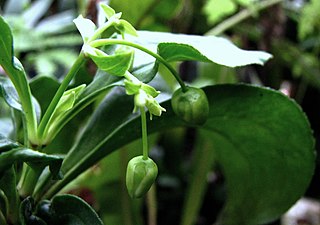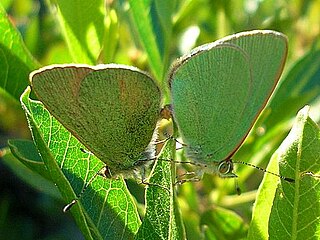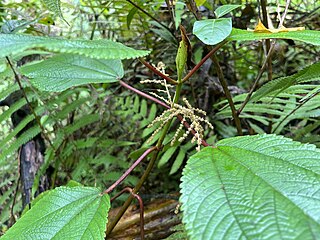
Acacia koa, commonly known as koa, is a species of flowering tree in the family Fabaceae. It is endemic to the Hawaiian Islands, where it is the second most common tree. The highest populations are on Hawaiʻi, Maui and Oʻahu.
Hawaiian hibiscus are seven species of hibiscus native to Hawaii. The yellow hibiscus is Hawaii's state flower. Most commonly grown as ornamental plants in the Hawaiian Islands are the non-native Chinese hibiscus and its numerous hybrids, though the native Hibiscus arnottianus is occasionally planted.

Kapa is a fabric made by native Hawaiians from the bast fibres of certain species of trees and shrubs in the orders Rosales and Malvales. The bark is beaten and felted to achieve a soft texture and dye stamped in geometric patterns.

Alyxia stellata, known as maile in Hawaiian, is a species of flowering plant in the dogbane family, Apocynaceae, that is native to Hawaii. It grows as either a twining liana, scandent shrub, or small erect shrub, and is one of the few vines that are endemic to the islands. The leaves are usually ternate, sometimes opposite, and can show both types on the same stem. Flowers are quite inconspicuous and have a sweet and light fragrance of honey. The bark is most fragrant and exudes a slightly sticky, milky sap when punctured, characteristic of the family Apocynaceae. The entire plant contains coumarin, a sweet-smelling compound that is also present in vanilla grass, woodruff and mullein. Fruit are oval and dark purple when ripe. Maile is a morphologically variable plant and the Hawaiian names reflect this.

The Kamehameha butterfly is one of the two species of butterfly endemic to Hawaii, the other is Udara blackburni. The Hawaiian name is pulelehua. This is today a catch-all native term for all butterflies; its origin seems to be pulelo "to float" or "to undulate in the air" + lehua, "reddish", or "rainbow colored", probably due to the predominant color of the Metrosideros polymorpha flower: an animal that floats through the air, from one lehua to another. Alternatively, it is called lepelepe-o-Hina – roughly, "Hina's fringewing" – which is today also used for the introduced monarch butterfly.

The Hawaiian tropical rainforests are a tropical moist broadleaf forest ecoregion in the Hawaiian Islands. They cover an area of 6,700 km2 (2,600 sq mi) in the windward lowlands and montane regions of the islands. Coastal mesic forests are found at elevations from sea level to 300 m (980 ft). Mixed mesic forests occur at elevations of 750 to 1,250 m, while wet forests are found from 1,250 to 1,700 m. Moist bogs and shrublands exist on montane plateaus and depressions. For the 28 million years of existence of the Hawaiian Islands, they have been isolated from the rest of the world by vast stretches of the Pacific Ocean, and this isolation has resulted in the evolution of an incredible diversity of endemic species, including fungi, mosses, snails, birds, and other wildlife. In the lush, moist forests high in the mountains, trees are draped with vines, orchids, ferns, and mosses. This ecoregion includes one of the world's wettest places, the slopes of Mount Waiʻaleʻale, which average 373 in (9,500 mm) of rainfall per year.

Hibiscus waimeae is a species of flowering plant within the okra family, Malvaceae, that is endemic to the island of Kauaʻi in Hawaii.

Sophora chrysophylla, known as māmane in Hawaiian, is a species of flowering plant in the pea and bean family, Fabaceae, that is endemic to Hawaii. It is highly polymorphic, growing as a shrub or tree, and able to reach a height of 15 m (49 ft) in tree form. Yellow flowers are produced in winter and spring.

Mezoneuron kauaiense is a rare shrub or small tree in the genus Mezoneuron, that is endemic to Hawaii. Common names include uhiuhi, kāwaʻu (Maui), and kea (Maui). It is threatened by invasive species, particularly feral ungulates.

Hibiscadelphus giffardianus is a species of flowering plant in the mallow family Malvaceae that is endemic to the Big Island of Hawaii.

Schiedea trinervis, also called three nerved alsinidendron, is a species of flowering plant in the family Caryophyllaceae, that is endemic to island of Oʻahu in Hawaii. It is a subshrub, reaching a height of 30–80 cm (12–31 in).

Polyscias sandwicensis, known as the 'ohe makai or ʻOhe kukuluāeʻo in Hawaiian, is a species of flowering plant in the family Araliaceae, that is endemic to Hawaii. It is a tree, reaching a height of 4.6–15 m (15–49 ft) high with a trunk diameter of 0.5–0.6 m (1.6–2.0 ft). It can be found at elevations of 30–800 m (98–2,625 ft) on most main islands. Polyscias sandwicensis generally inhabits lowland dry forests, but is occasionally seen in coastal mesic and mixed mesic forests. It is threatened by habitat loss.

Urera kaalae, opuhe, is a species of flowering plant in the nettle family, Urticaceae, that is endemic to the island of Oʻahu in Hawaii. It inhabits slopes and gulches in mesic forests at elevations of 300–760 m (980–2,490 ft). Currently it is restricted to the southern and central parts of the Waiʻanae Mountains. Associated plants include maile, hame, Asplenium kaulfusii, Athyrium spp., ʻāwikiwiki, pāpala, ʻakoko, poʻolā, ēlama, Doryopteris spp., ʻieʻi.e., manono, Hibiscus spp., olopua, māmaki, hala pepe, ʻālaʻa, kōpiko, heuhiuhi, aʻiaʻi, ōpuhe, and maua. It is threatened by habitat loss.

Santalum freycinetianum, the forest sandalwood, Freycinet sandalwood, or ʻIliahi, is a species of flowering tree in the European mistletoe family, Santalaceae, that is endemic to the Hawaiian Islands. Its binomial name commemorates Henri Louis Claude de Saulces de Freycinet, a 19th-century French explorer. ʻIliahi inhabits dry, coastal mesic, mixed mesic, and wet forests on Oʻahu, Kauaʻi, Lānaʻi, Maui, and Molokaʻi at elevations of 250–950 m (820–3,120 ft). It grows in areas that receive 500–3,800 mm (20–150 in) of annual rainfall. Like other members of its genus, ʻiliahi is a root hemi-parasite, deriving some of its nutrients from the host plant; common hosts include koa, koaiʻa, and ʻaʻaliʻi.

Streblus pendulinus, commonly known as Hawai'i roughbush or aʻiaʻi, is a species of flowering plant in the mulberry family, Moraceae, that is native to eastern Australia, Melanesia, Micronesia, and Polynesia. It is usually a small tree or shrub, reaching a height of 12 metres with a trunk diameter of 0.6 m (2 ft). In Hawaii, it inhabits dry, coastal mesic, mixed mesic and wet forests from sea level to an altitude of 1,675 m (5,495 ft).

Nestegis sandwicensis, commonly known as Hawai'i olive or olopua, is a species of flowering tree in the olive family, Oleaceae, that is endemic to Hawaii. It is found on all major islands at elevations of 30–1,300 m (98–4,265 ft) in coastal mesic and mixed mesic forests, and, especially, dry forests. It usually reaches a height of 6 m (20 ft) with a trunk diameter of 0.2 m (0.66 ft), but may reach 20 m (66 ft) in height with a trunk diameter of 0.9 m (3.0 ft).

Rhus sandwicensis, commonly known as neneleau, neleau or Hawaiian sumac, is a species of flowering plant in the cashew family, Anacardiaceae, that is endemic to Hawaii. It is small tree, reaching a height of 4.5–7.5 m (15–25 ft) and a trunk diameter of 10–30 cm (3.9–11.8 in). Neneleau inhabits dry, coastal mesic, mixed mesic and wet forests at elevations of 180–610 m (590–2,000 ft) on all main islands.

Leptecophylla tameiameiae, known as pūkiawe or maiele in the Hawaiian language, is a species of flowering plant that is native to the Hawaiian and Marquesas Islands. The specific epithet honors King Kamehameha I, who formed the Kingdom of Hawaiʻi. It grows as a tree up to 4.6 m (15 ft) tall in forests and as a shrub 0.9–3 m (3.0–9.8 ft) in height elsewhere. Its small needle-like leaves are whitish underneath, dark green above. The round berries range in color from white through shades of pink to red. Pūkiawe is found in a variety of habitats in Hawaii at elevations of 15–3,230 m (49–10,597 ft), including mixed mesic forests, wet forests, bogs, and alpine shrublands.

Udara blackburni, the Koa butterfly, is a butterfly in the family Lycaenidae that is endemic to Hawaiʻi. It is also known as Blackburn's butterfly, Blackburn's bluet, Hawaiian blue or green Hawaiian blue.

Boehmeria grandis, commonly called ʻakolea, is a flowering species of the Urticaceae family that is endemic to the Hawaiian Islands. ʻakolea can be found in mesic to wet forests across Hawaiʻi along streams, on ridges, and valley floors. Multiple sources have cited observations in Makaua Gulch on Oʻahu.



















